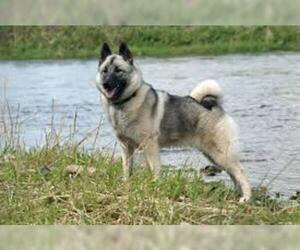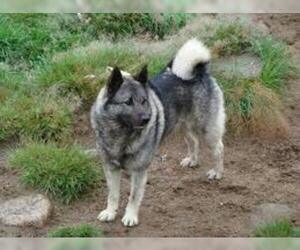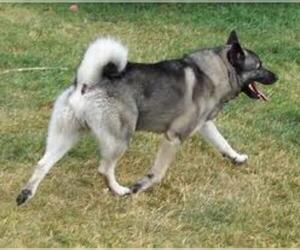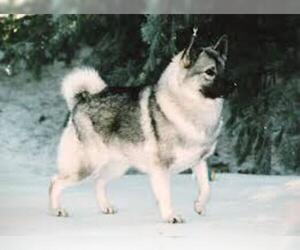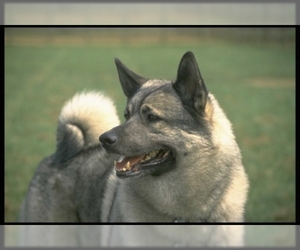
All about Norwegian Elkhound dog breed
A.K.A. :Elkhound, Norsk Elghund Grå, Gra Elghund, Grey Elkhound, Norsk Elghund Sort, Sort Elghund, Black Elkhound, Norwegian Bear Dog, Moose Hound, Grey Moose Hound, Black Moose Hound, Elk Dog, Norwegian Hunting Dog, Norsk Elghund, Elghund Grå, Elghund Sort, Elkie
Size
Grooming requirements
Exercise requirements
Good with other dogs
Watchdog ability
Energetic
Training requirements
Playful
Affectionate
Good with other pets
Good with children
Good with strangers
Winter
Summer
Healthiness
Protective
Life Span
| Pure Breeds | Member |
| Breeds A - Z | N |
| Breeds by Group | Hound Northern |
| Breeds by Trait | Good With Kids High Stamina Dog Breeds Smartest Dog Breeds |
| Overview: | The Norwegian Elkhound is a robust and ancient breed, originating in Scandinavia where it served as a versatile hunting dog, primarily for large game like moose (elk). Physically, they are distinctive with their thick, weather-resistant double coat, typically in shades of grey and black, and their medium build, weighing generally between 48-55 pounds. Their curled tail and prick ears add to their alert and intelligent appearance. Temperamentally, Elkhounds are known for being loyal, courageous, and remarkably friendly with their families, often displaying a playful and affectionate nature. While they can be excellent companions for active families, their independent streak and high energy levels mean they require consistent training and plenty of exercise; they are generally not well-suited for small apartment living without significant effort to meet their needs. Like many breeds, they can be prone to certain health conditions such as hip dysplasia and progressive retinal atrophy, making responsible breeding and regular veterinary check-ups important for their well-being. |
F.A.Q.
All You Need to Know About the Norwegian Elkhound Breed
The Norwegian Elkhound is a majestic and ancient spitz-type breed, originating in Norway where it was prized for hunting elk and bear. Known for its courageous, intelligent, and affectionate temperament, this breed makes an excellent family companion. Physically, Elkhounds are medium-sized dogs with a distinctive silver-grey double coat, curled tail, and watchful expression. While adaptable, they thrive in homes with active families who can provide consistent training and mental stimulation. Their high energy levels mean they require daily exercise, making apartment living challenging unless ample outdoor activity is guaranteed. Grooming involves regular brushing, especially during shedding seasons, to manage their dense coat. Generally robust, common health considerations include hip dysplasia, progressive retinal atrophy, and Fanconi syndrome. Prospective owners should be prepared for a devoted, vocal, and lively partner perfect for an active lifestyle.Norwegian Elkhound Weight: Average Size & Healthy RangeThe average weight for an adult Norwegian Elkhound is approximately 50-60 pounds.* Males: Typically weigh between 50-60 pounds.* Females: Generally weigh between 45-55 pounds.Maintaining a healthy weight for a Norwegian Elkhound is crucial for their well-being. This range represents the typical size for a well-conditioned adult.
How Tall is a Norwegian Elkhound? (Average Height & Size)
The average height of a Norwegian Elkhound, measured at the shoulder, typically falls between 19.5 and 20.5 inches. These sturdy and medium-sized dogs have a fairly consistent build, but there can be slight variations based on gender and individual genetics.Here's a breakdown of the typical adult Norwegian Elkhound height:* Males: Generally stand a bit taller, with an average height of around 20.5 inches (52 cm).* Females: Tend to be slightly smaller, averaging about 19.5 inches (49.5 cm) at the shoulder.So, when considering the Norwegian Elkhound's average size, you can expect most adults to be in the 19.5 to 20.5-inch range. While these are the breed standards, individual puppies might mature to be a little shorter or taller depending on their lineage and overall health. This robust build makes them well-suited for their original purpose as hunting companions.The Norwegian Elkhound breed primarily comes in one officially recognized color combination: various shades of grey with black tips. This ranges from light grey to dark grey, always with a lighter undercoat and silver-grey markings on the chest, mane, and legs. This grey with black tips is the only AKC recognized Norwegian Elkhound color.There are no rare coat types or exotic Norwegian Elkhound variations such as blue, lilac, merle, chocolate, brindle, fawn, cream, or white that are natural to the breed or accepted by major kennel clubs. Any claims of such colors would indicate a mixed breed or a genetic anomaly not characteristic of the purebred Norwegian Elkhound. When searching for Norwegian Elkhound colors, buyers should expect the classic grey and black tipped coat.
The Norwegian Elkhound personality is generally described as loyal, courageous, and independent. They are very friendly and form strong bonds with their families, making them excellent companions. While sociable with their "pack," their temperament of Norwegian Elkhound can be somewhat reserved with strangers initially, but they are rarely aggressive.They are adaptable to apartment living provided they receive sufficient daily exercise, but ideally thrive in homes with a yard. They are generally good with children, especially if raised with them, showing patience and a playful side. However, their strong prey drive means they may require careful introduction and supervision with other pets, particularly smaller, non-canine animals. With proper socialization, they can coexist peacefully with other dogs. Their independence means they can be a bit stubborn, so consistent training is essential.
The Norwegian Elkhound temperament is a captivating blend of independence and devotion, making them a unique companion. Known for their courageous and alert nature, they are also deeply loyal to their families. Elkhounds are generally friendly and sociable with people, often greeting strangers with a wagging tail, though they possess a watchful instinct that makes them excellent—if vocal—watchdogs. Their intelligence is high, but they also have a strong-willed, somewhat stubborn streak that requires consistent and patient training. They are not overly sensitive but respond best to positive reinforcement rather than harsh methods.
Regarding other pets, early socialization is crucial. While typically good with children they are raised with, their independent nature means they appreciate respect for their space; supervision with very young children is always recommended. They can coexist peacefully with other dogs if introduced properly, but their hunting heritage means small, non-canine pets might trigger their prey drive. Adaptability to apartment living is challenging due to their high energy levels and need for regular exercise. They thrive in homes with a yard and an active lifestyle, needing plenty of mental and physical stimulation to prevent boredom and destructive behaviors. This breed truly shines as an active, engaged member of a loving family, offering unwavering loyalty and a spirited personality.Norwegian Elkhound Care: Daily Maintenance & Health TipsNorwegian Elkhound care is relatively straightforward, making them excellent companions for active families. They are not a low-energy dog breed; in fact, Elkhounds require consistent daily exercise—at least 60 minutes of vigorous activity like running, hiking, or vigorous play—to prevent boredom and destructive behaviors. Despite their thick double coat, grooming needs are moderate. Regular brushing (2-3 times weekly, daily during shedding seasons) is essential to manage shedding and prevent matting. While their ears are pricked, occasional ear cleaning is still necessary to prevent wax buildup and infections. Unlike some breeds, Elkhounds do not have significant wrinkles, so wrinkle cleaning is not a concern.Dietary considerations involve a high-quality, age-appropriate dog food. Due to their tendency to gain weight, weight management is crucial; avoid overfeeding and limit treats. Common health concerns for Norwegian Elkhounds include hip and elbow dysplasia, progressive retinal atrophy, and specific thyroid issues. Regular veterinary check-ups are key for early detection. Maintaining good dental care through brushing and dental chews is vital to prevent periodontal disease. They are generally not climate sensitive due to their weather-resistant coat, thriving in cooler climates but tolerating warmer weather with access to shade and water. For how to care for a Norwegian Elkhound, focus on consistent exercise, regular grooming, a balanced diet, and proactive veterinary care to ensure a long, healthy life.
Norwegian Elkhound Activity Level: Understanding Their Energy NeedsHow active are Norwegian Elkhounds? The Norwegian Elkhound activity level is best described as moderately active, balancing periods of surprising energy with a strong preference for rest. They are historically hunting dogs, built for endurance over long distances in cold climates, but not for constant, high-intensity sprinting.Typical energy levels involve short bursts of enthusiastic play or work, followed by equally long, if not longer, periods of napping and relaxation. They are not perpetually "on" like some high-drive working breeds.Norwegian Elkhound exercise needs typically include at least 60 minutes of dedicated physical activity daily. This can be broken into several sessions and should include a mix of:* Brisk walks or jogs: Long, steady walks are excellent for their stamina.* Off-leash playtime in a secure area: They enjoy exploring and scent-tracking.* Interactive games: Fetch, tug-of-war, and puzzle toys are great for mental and physical stimulation.* Hiking: Their natural inclination for tracking makes them excellent hiking companions.Playtime preferences lean towards engaging activities that stimulate their intelligence and sense of smell. They love to "work" for their fun, whether it's tracking a hidden treat or playing a game of hide-and-seek.It's important to note limitations due to their brachycephalic anatomy. While not as extreme as some flat-faced breeds, Norwegian Elkhounds do have a slightly shorter muzzle. This means they are more susceptible to overheating, especially in warm weather or during strenuous exercise. Always monitor them closely, provide plenty of water, and avoid intense activity during the hottest parts of the day.Are Norwegian Elkhounds suitable for active families or low-energy households? They are suitable for active families who enjoy outdoor activities and are committed to providing consistent daily exercise. They thrive with owners who understand their need for both physical and mental stimulation. They are generally not suitable for low-energy households that cannot meet their daily exercise requirements, as boredom can lead to destructive behaviors. While they enjoy their rest, they will not be content being couch potatoes 24/7. Owners should be prepared to engage with them actively for a good portion of the day.
Breed Breakdown: What Experts Say About the Norwegian Elkhound
I would rate the Norwegian Elkhound's "Size" trait as a 7.While not a giant breed, the Norwegian Elkhound is a robust and substantial dog. They typically stand between 19.5 to 20.5 inches tall at the shoulder and weigh 48 to 55 pounds, with a very sturdy, muscular, and deep-chested body structure built for endurance and working in challenging terrain. Compared to many common companion dogs like Shih Tzus, Chihuahuas, or even Beagles, they are significantly larger and heavier. However, they don't reach the imposing size of breeds like Great Danes, Mastiffs, or Irish Wolfhounds. Their size makes them a moderate-to-large breed.Due to their robust size and significant exercise requirements, Norwegian Elkhounds are not ideally suited for apartment living unless their owners are extremely dedicated to providing ample daily outdoor activity and mental stimulation. Their deep bark can also be an issue in close quarters. Travel can be manageable for them, especially by car, but their size might make air travel more complex and expensive due to crate requirements. For households with space constraints, they would likely struggle without a dedicated outdoor area or owners committed to frequent, extended outdoor adventures. They thrive in homes with some yard space and active families who can accommodate their physical needs.
I would rate the Norwegian Elkhound's "Grooming Requirements" at a 6 out of 10.While not exceptionally high-maintenance, the Elkhound's dense double coat is the primary factor preventing a lower score. This coat sheds heavily twice a year (known as "blowing coat"), requiring frequent and thorough brushing to manage the loose fur and prevent matting. Regular brushing, even outside of shedding season, is crucial to keep the coat healthy and free of tangles, and to distribute natural oils. They aren't prone to skin folds or excessive ear wax, so those aspects are generally easy. Nail trimming is standard for most breeds and should be done regularly. Bathing isn't a weekly affair but is needed periodically, perhaps every 1-2 months or as needed, without overdoing it to preserve their natural skin oils. They aren't particularly susceptible to skin issues or allergies more than other breeds, as long as their coat is properly maintained. Compared to breeds with short, single coats, they require more dedicated grooming, but they don't demand the intricate styling or specialized care of breeds with long, silken, or corded coats. Their grooming is more about consistent effort to manage shedding and maintain coat health rather than complex techniques.
I would rate the Norwegian Elkhound's "Exercise Requirements" a 7 out of 10.While not in the extreme "working dog all day" category, Elkhounds possess a robust energy level and a strong desire for activity that sets them well above breeds content with a short daily stroll. Their history as a hunting dog, tracking large game over vast distances, speaks to their endurance and stamina. They thrive on sustained movement and require more than just backyard playtime to stay healthy and mentally stimulated. Daily, structured exercise is crucial; a brisk walk or jog for at least an hour, or even longer, is often recommended. They enjoy various types of exercise, from hiking and running to playtime in a secure area. Without adequate physical and mental stimulation, Elkhounds can become bored, leading to destructive behaviors or excessive barking. They are not a breed that thrives with minimal activity; rather, they require consistent, engaging routines to maintain their physical condition and a balanced temperament. Their non-brachycephalic anatomy means they generally have good respiratory capacity for sustained effort.
I would rate the Norwegian Elkhound's "Watchdog Ability" at a 7.Elkhounds are naturally alert and possess keen senses, making them quick to notice unusual sights or sounds. Their territorial instincts are present, and they will typically bark to signal the arrival of unfamiliar people or anything perceived as out of place. This barking is often a deep, resonant sound that can certainly act as an early warning system, alerting their owners to potential issues. While they aren't inherently aggressive guard dogs, their size and persistent barking can be a deterrent to casual intruders. They are more than just passive companions; they are quite capable of providing meaningful early warnings in a home environment due to their vigilance and vocal nature, even if their primary role isn't to physically engage with threats. However, they are also known to be friendly once introduced, which means they might not maintain a strong deterrent posture once a stranger is clearly no longer a threat.
I would rate the Norwegian Elkhound's "Good with Other Dogs" trait as a 6 out of 10.While generally not overtly aggressive towards other dogs, Norwegian Elkhounds tend to be more independent and assertive than truly "dog-friendly" breeds. Their strong prey drive and hunting instincts can sometimes translate into a desire to chase or "herd" smaller, faster dogs, and they can be quite dominant if not properly socialized and trained from a young age. They are often tolerant of other dogs, especially those they've grown up with, but they don't necessarily thrive on constant canine companionship in the way some retriever or herding breeds do. Introductions to unfamiliar dogs, particularly those of the same sex or similar energy level, require careful supervision and a calm approach to prevent potential dominance displays. They can coexist peacefully in multi-dog households, but they often require clear leadership from their human and may not always be the first to initiate playful interactions with new canine acquaintances. Their adaptability depends heavily on early and consistent socialization, which is crucial to ensure they learn appropriate dog-to-dog etiquette.
I'd rate the Norwegian Elkhound's "Energetic" trait a 7 out of 10.While not hyperactive like some working breeds, the Elkhound is undeniably an active and robust dog. They possess significant endurance, bred to track game over long distances in rugged terrain, which translates to a high need for daily physical stimulation. Their playfulness is moderate to high, often enjoying engaging in activities with their owners. They excel in outdoor and athletic activities like hiking, jogging, and even some dog sports. Compared to many companion dogs, they are naturally active and require substantial exercise to prevent boredom and destructive behaviors. However, they are not brachycephalic; they have a distinct, strong muzzle, which actually benefits their stamina and exercise tolerance, allowing for efficient breathing during strenuous activity, unlike breeds with shortened snouts that often struggle with heat and exertion.
I'd rate the Norwegian Elkhound's "Training Requirements" a 7.While intelligent and capable of learning a wide range of commands, Elkhounds are also known for their independent and somewhat stubborn nature. Their history as a hunting dog that works alongside, but not entirely dependent on, a human has ingrained a certain self-reliance. This means they require a consistent and patient approach to training. While not impossible for a dedicated beginner, their "what's in it for me?" attitude and potential for selective hearing can be frustrating for someone without prior dog training experience. They respond very well to positive reinforcement and food motivation, but a firm yet fair hand is needed to establish boundaries and maintain focus. Short, engaging training sessions are more effective than long, repetitive ones due to their attention span. Structured routines from a young age are crucial to channel their energy and prevent them from developing their own, potentially less desirable, rules. They are not a breed that can be left to their own devices and expected to be perfectly behaved; they thrive with clear expectations and consistent leadership.
I would rate the Norwegian Elkhound's "Playful" trait a 7 out of 10.While not hyperactive like some terrier breeds, Elkhounds possess a solid, enduring playfulness. They have a good typical activity level and generally love games, especially those involving their strong prey drive, like fetch or chasing. They definitely enjoy interaction and will often seek out attention for playtime, nudging you with their nose or bringing a toy. They respond well to toys and playtime, showing enthusiasm in daily life through their curious and often boisterous demeanor. They are naturally spirited dogs, but their playfulness is often intertwined with their independent and intelligent nature, meaning they might engage in playful antics on their own or require a bit more prompting than a dog whose sole purpose seems to be chasing a ball. Compared to some extremely high-energy companion dogs, they can appear more laid-back, but they are far from inactive or uninterested in fun.
I would rate the Norwegian Elkhound's "Affectionate" trait at a 7. They are undeniably loyal and develop strong bonds with their families, often following them from room to room. They are sensitive to owner emotions and desire human companionship, finding comfort in being near their people. However, they are also quite independent and possess a working dog mentality, meaning they aren't typically excessive cuddlers or lap-sitters in the way some other companion breeds might be. While they appreciate affection and will lean into a good petting session, they generally aren't needy or overly demonstrative. They thrive on affection in the sense that they want to be part of the family and involved in activities, but their expression of love is often more subtle and less physically demanding compared to breeds that are constantly seeking close physical contact.
I would rate the "Good with Other Pets" trait of the Norwegian Elkhound a 6 out of 10.Norwegian Elkhounds generally fall into a moderate category for coexisting with other pets. Their typical behavior around other dogs is often quite good, as they are a pack-oriented breed by nature and can enjoy the company of other canines. However, their prey drive is a significant factor to consider, particularly with smaller, fast-moving animals like cats or rabbits. This heritage as a hunting dog means they have an instinct to chase, which can be challenging to overcome with felines or pocket pets, though early and consistent socialization can mitigate this. Resource guarding tendencies are not typically a dominant trait, but like any dog, individual personalities vary, and proper training and management are always beneficial. To achieve peaceful coexistence in a multi-pet household, Norwegian Elkhounds definitely require early and ongoing socialization, along with consistent training and supervision, especially with non-canine pets. They are not naturally sociable with all species in the same way a truly "bomb-proof" pet-friendly breed might be, but with dedicated effort, they can learn to live harmoniously with other animals.
I'd rate the Norwegian Elkhound's "Good with Children" trait a 6 out of 10.While not inherently aggressive, they aren't the most naturally gentle or overtly affectionate breed with young children. Their independent and sometimes headstrong nature means they generally thrive with older, more respectful children who understand how to interact with dogs. They are tolerant of noise and some handling, but can be less patient with very boisterous or clumsy toddlers who might pull fur or invade their space. Playfulness is there, particularly with active kids who can engage them in games or outdoor activities. To truly thrive in a family setting with children, especially younger ones, extensive socialization from a young age and consistent positive reinforcement training are absolutely essential. Supervision is always recommended, as their strong prey drive and herding instincts can sometimes be misinterpreted by very small children. They are loyal and protective of their family, but this manifests more as guarding than as a soft, cuddly companion for a child.
I would rate the Norwegian Elkhound's "Good with Strangers" trait a 6.Norwegian Elkhounds are generally friendly and accepting of strangers, but they aren't typically as effusively outgoing as some other breeds. They are known for their strong guarding instincts and can be initially reserved or watchful when encountering unfamiliar adults. While not inherently unfriendly, their alert nature means they might bark to announce a newcomer or keep a watchful eye, rather than immediately seeking interaction. With proper early socialization, they can be very comfortable and well-behaved in public or guest-filled environments, but without it, their natural wariness can be more prominent. They aren't naturally extremely sociable; rather, they require consistent and positive exposure to various people from a young age to develop a confident and welcoming demeanor with strangers.
I would rate the Norwegian Elkhound's "Winter" tolerance at a 9 out of 10.Norwegian Elkhounds are exceptionally well-suited for cold weather due to their dense, double coat, which provides excellent insulation. They have a thick undercoat and a coarser outer coat that sheds water and snow. Their medium-large size and athletic build contribute to good body heat regulation, and while they aren't overly bulky, they possess adequate body fat for cold conditions. Their dolichocephalic (long-nosed) anatomy is advantageous, as it allows for proper warming and humidifying of inhaled air before it reaches the lungs, reducing the risk of respiratory issues in cold, dry air, unlike brachycephalic breeds. Consequently, their risk of hypothermia is quite low under typical winter conditions, and they thrive on outdoor activity in cold climates. Compared to many other companion dogs, Norwegian Elkhounds generally do not require special care during winter months beyond ensuring they have access to shelter, food, and water, and are not left unattended for excessively long periods in extreme conditions. In fact, they often become more energetic and playful in colder temperatures.
I would rate the Norwegian Elkhound's "Summer" tolerance as a 3.Norwegian Elkhounds are a Nordic breed, designed for cold climates. They possess a thick, double coat that provides excellent insulation against the cold but becomes a significant disadvantage in heat. While not brachycephalic, their dense coat severely impedes their ability to regulate body temperature effectively through panting and convection. This puts them at a high risk of heatstroke, even with moderate exercise in warm weather. They require significant modifications to their outdoor activity levels during summer, often limited to early mornings or late evenings on cooler days, and even then, close monitoring is essential. Compared to many other companion dogs, Norwegian Elkhounds absolutely require special care in summer months, including access to air conditioning, shade, cool water, and often the avoidance of outdoor activity altogether during peak heat. Their natural physiology is simply not equipped for hot weather, making them quite sensitive to summer conditions.
I would rate the Norwegian Elkhound's "Healthiness" trait as an 8 out of 10.Norwegian Elkhounds are generally a very robust and hardy breed, benefiting from their ancient working dog lineage. They typically enjoy a good life expectancy of 12-14 years, which is excellent for a medium to large-sized dog. They don't have the severe conformational issues that lead to breathing difficulties or profound joint problems common in some other breeds. While they can be predisposed to certain conditions like hip and elbow dysplasia, progressive retinal atrophy, and occasionally fanconi syndrome (though less common now with good breeding practices), these are often manageable with responsible breeding and early detection. They aren't particularly prone to chronic skin conditions or allergies either, compared to some breeds. Their thick double coat requires regular grooming, but this is more about maintenance than addressing a health issue. Overall, they are considered a generally robust breed with a strong constitution, rather than high-maintenance from a health perspective, provided they receive proper care, nutrition, and regular veterinary check-ups.
I would rate the Norwegian Elkhound's "Protective" trait at a 7 out of 10.Elkhounds are naturally alert and have a keen sense of their surroundings. Their territorial instincts are present, leading them to bark at unfamiliar sights or sounds, making them excellent watchdogs. They are fiercely loyal to their owners and family, and will instinctively position themselves between their loved ones and a perceived threat. While they are generally friendly with strangers once properly introduced, their initial reaction can be reserved and watchful, often accompanied by a deep, resonant bark. This combination of alertness, territoriality, and vocalization makes them very effective at deterring intruders and alerting their owners to potential dangers. However, it's important to note that their protective nature primarily manifests as a warning system; they are not typically aggressive attack dogs. While their size and presence can be intimidating, they are more inclined to be a companion dog that will courageously warn and defend their household through their presence and vocalizations, rather than engaging in a direct physical confrontation like a trained guard dog would. They offer meaningful "protection" in the sense of being an incredibly reliable and loud alarm system, providing a strong deterrent effect.
I would rate the Norwegian Elkhound's "Life Span" trait a 7 out of 10.The Norwegian Elkhound is generally considered a long-lived breed compared to many other companion dogs. Their average life expectancy typically ranges from 12 to 14 years, with many individuals living beyond that with proper care. While they are prone to a few health issues like hip dysplasia and progressive retinal atrophy, responsible breeding practices help to minimize the incidence of these genetic conditions. Furthermore, their robust build, generally moderate activity levels, and a diet appropriate for their size contribute to their longevity. With diligent care, including a balanced diet, regular exercise, and preventative veterinary check-ups, Elkhounds often enjoy a full and healthy life.
Norwegian Elkhound Dogs for adoptionSee all dogs for adoption
Norwegian Elkhound BreedersSee all breeders
Similar Dog Breeds for Norwegian Elkhound
Breed Mixes of Norwegian Elkhound
Quick Breed Selector 0 - not important, 1 - smallest, 10 - largest
Variants & Mistakes :Norweigan Elkhound, Norweigen Elkhound, Norwegian Elk hound, Norwegian Elkhoud, Norwegian Elkhounde, Norwegion Elkhound, Norweigian Elkhound, Norweigian Elk hound, Norweigian Elkhounde, Norweigian Elkhoud, Nrowegian Elkhound, Norwegean Elkhound, Norweign Elkhound, Norwiegan Elkhound, Norwegin Elkhound, Norwegan Elkhound, Norweigan Elk hound, Norweigen Elk hound, Norweigian Elkound, Norgwegian Elkhound, Norgweigan Elkhound, Noregion Elkhound, Norwegain Elkhound, Norweign Elk hound, Norwiegen Elkhound, Norwigian Elkhound, Norweign Elkhoud, Norwigian Elkhoud, Norwegien Elkhound, Norwegian Ekhound, Norwegian Elk houn, Norwegian Elkound, Norwegian Elkhund, Norwegan Elkhoud, Norwegean Elkhoud, Norweigan Elkhund, Norweigen Elkhund, Norwigian Elkhund, Norwigen Elkhound, Norweigien Elkhound, Norweigan Elkhoun, Norweigen Elkhoun, Norwigian Elkhoun, Norwigen Elk hound, Nowergian Elkhound, Nowergian Elk hound, Norweigain Elkhound, Norwegein Elkhound
